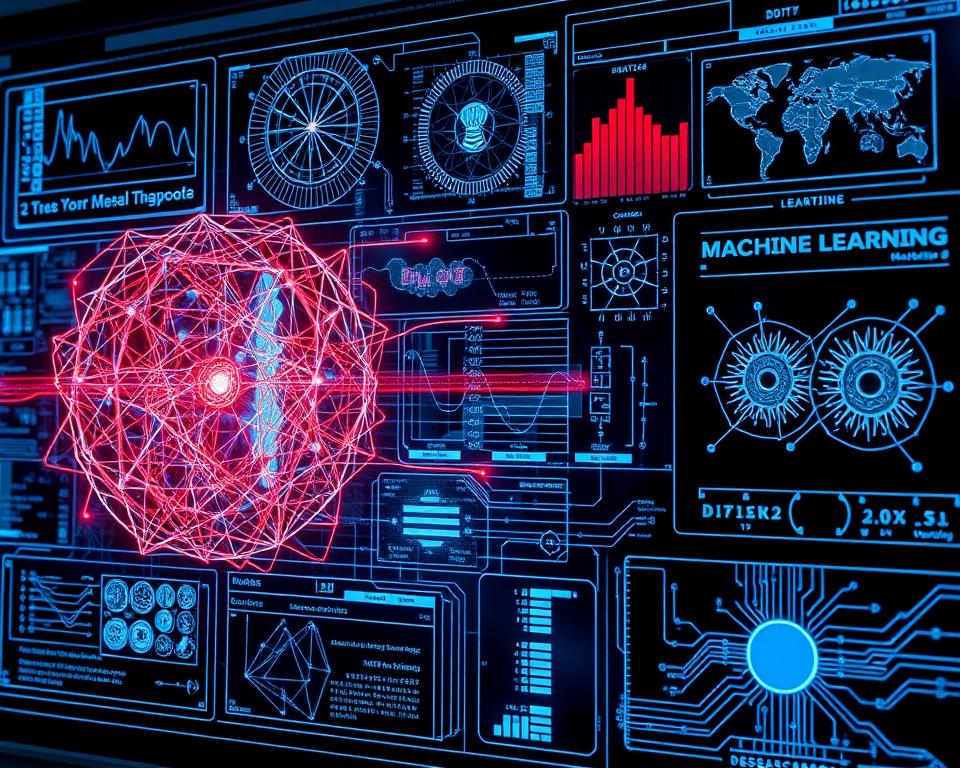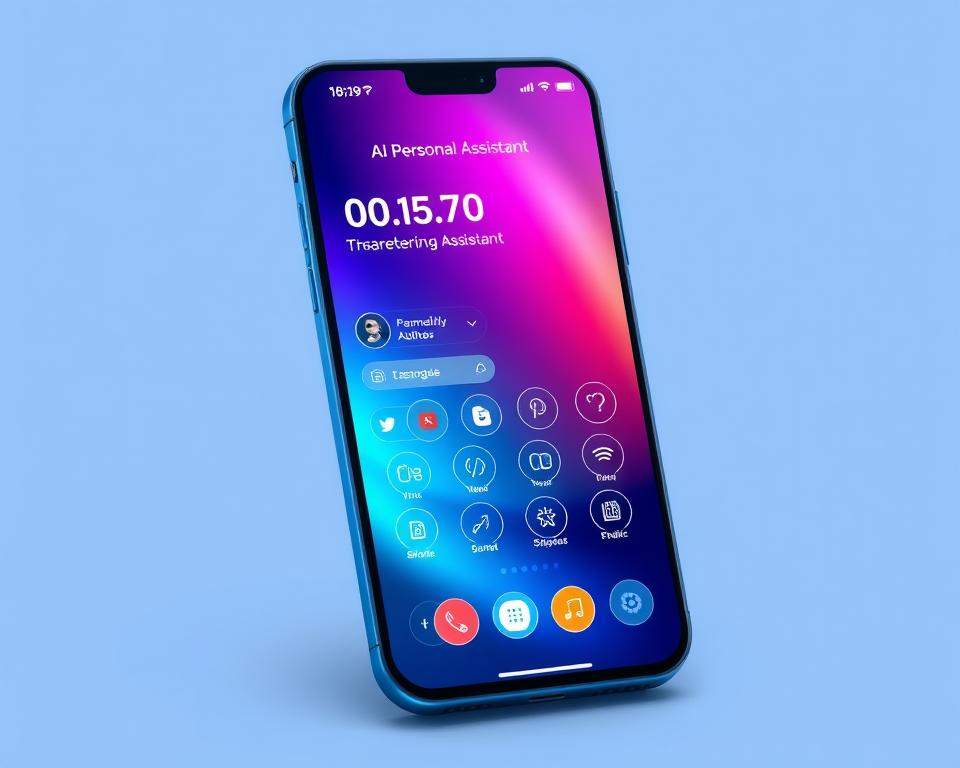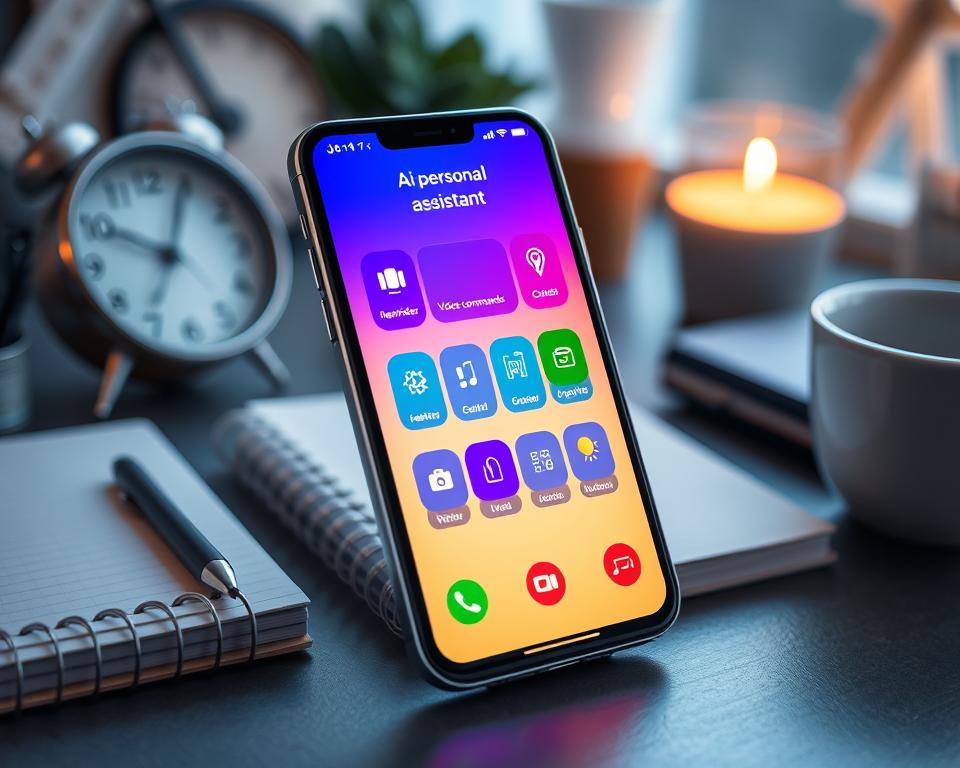The world of technology is changing fast, thanks to artificial intelligence (AI). AI has made personal assistant apps a reality. These apps can change our lives by helping us, making tasks easier, and boosting our productivity.
As more people want smart, helpful personal assistants, app makers face a big challenge. They need to blend AI with what users want. This means understanding AI, the app’s features, and the tech needed to make it work.
This article will dive into making an AI-powered personal assistant app. We’ll look at the app’s features, how it works, and the hurdles developers face. We’ll also cover the latest in AI, natural language processing, and design for a great user experience. Our goal is to guide you through the exciting world of AI assistant app development.
Table of Contents
Key Takeaways
- Understand the core concepts and functionality of AI personal assistants
- Explore the essential features and capabilities required for modern AI assistant apps
- Discover the integration requirements for natural language processing and machine learning models
- Learn about the user interface design principles and accessibility considerations for AI assistants
- Examine the data privacy, security, and cloud infrastructure requirements for AI assistant development
Understanding AI Personal Assistants: Core Concepts and Functionality
AI personal assistants have changed how we use technology. They make our lives easier by doing tasks for us and giving us personal help. Let’s look at what they can do, their parts, and how they’ve grown over time.
Types of AI Assistants in Modern Applications
There are many kinds of AI personal assistants. Each one meets different needs. Here are a few examples:
- Voice-based assistants, like Siri, Alexa, and Google Assistant, work with voice commands for easy use.
- Text-based chatbots use natural language to chat and help through messages.
- Hybrid assistants offer both voice and text features for more help.
Basic Components of AI Assistant Systems
AI personal assistants have key parts that help them work. These parts include:
- Natural Language Processing (NLP): Helps the assistant understand what you say or type.
- Speech Recognition: Turns spoken words into digital data for processing.
- Language Generation: Allows the assistant to give clear and fitting answers.
- Knowledge Bases: Store and find information to help with your questions and tasks.
Evolution of Personal Assistant Technology
The growth of AI personal assistants has been fast and exciting. They’ve moved from simple voice commands to advanced, multi-modal helpers. As AI and learning algorithms get better, we’ll see even smarter assistants in the future. They’ll make our lives even better.
Essential Features for Modern AI Personal Assistant Apps
The world is getting more connected and tech-driven. This means we need smart personal assistant apps more than ever. These AI app features help us work better, do daily tasks automatically, and get help that’s just for us. To stay ahead, these apps must have key features that meet our changing tech needs.
Natural language processing (NLP) is a key smart assistant functionality. It lets the AI understand and reply to voice and text commands. This makes talking to the AI feel natural, like talking to a person. Also, machine learning helps the AI get to know us better over time. It gives us advice and help that’s just right for us.
| Essential AI Personal Assistant Features | Benefits to Users |
|---|---|
| Voice and text-based commands | Convenient and hands-free interaction |
| Personalized task management | Increased productivity and organization |
| Intelligent information retrieval | Rapid access to relevant data and insights |
| Proactive recommendations and suggestions | Tailored assistance based on user preferences |
| Integration with smart home devices and IoT | Seamless control and automation of connected devices |
With these key features, modern AI personal assistant apps can change our lives for the better. They help us manage our days better and work more efficiently.
“The future of personal assistants lies in their ability to seamlessly integrate into our daily lives, anticipating our needs and providing tailored support at every turn.”
Natural Language Processing Integration Requirements
Creating an AI-powered personal assistant app needs NLP integration. NLP lets your assistant understand and talk back to you naturally. It includes speech recognition, text-to-speech, and language understanding.
Speech Recognition Components
The speech recognition part turns your voice into text for the AI. It uses complex algorithms to get it right. This makes your app work with just your voice.
Text-to-Speech Implementation
After understanding what you said, the AI talks back. It uses special tech to make the voice sound real. This makes talking to your app feel natural.
Language Understanding Modules
- Semantic analysis to comprehend the meaning and intent behind user utterances
- Intent recognition to map user inputs to specific commands or actions
- Entity extraction to identify key information such as names, places, or dates
- Context reasoning to maintain continuity and provide relevant responses
These modules are key to your AI assistant’s ability to talk like a human. Good NLP integration makes your app smart and easy to use.
“The true test of an AI assistant is not whether it can perform specific tasks, but whether it can engage in natural, coherent dialogue that feels human-like.”
Machine Learning Models for Personal Assistant Development
Creating a smart personal assistant app needs advanced machine learning models and algorithms. These models help the assistant understand natural language, know what the user wants, and give accurate, personal answers.
The natural language processing (NLP) module is key. It uses machine learning to understand human language. Training on lots of conversational data lets the assistant recognize speech, get the meaning, and respond well.
The machine learning-based decision-making system is also vital. It helps the assistant understand user requests, find the right data, and suggest actions. This uses supervised learning, like classification and regression, to match user inputs with the right outputs.
| Machine Learning Model | Application in Personal Assistants |
|---|---|
| Recurrent Neural Networks (RNNs) | Modeling and generating natural language for conversational responses |
| Convolutional Neural Networks (CNNs) | Analyzing images and visual data for image recognition and visual search |
| Long Short-Term Memory (LSTMs) | Handling long-term dependencies in language understanding and generation |
| Reinforcement Learning | Enabling the assistant to learn and improve its responses based on user feedback |
By using these algorithms and models, developers can make personal assistants that learn and help with many tasks and questions.
User Interface Design Principles for AI Assistants
AI-powered personal assistant apps are getting more common. Their user interfaces are key to a good user experience. To make these interfaces work well, we need to follow some important rules.
Voice Interface Guidelines
Creating a voice interface for an AI assistant needs careful thought. It’s important to make sure the language is clear and natural. This lets users talk to the assistant easily.
Offer simple voice commands and quick audio feedback. This makes talking to the assistant fun and interactive.
Visual Elements and Feedback Systems
Even though voice is main, visuals can help too. Use simple and clear visual signs, like status lights and animations. These give users visual feedback on what the assistant is doing.
Accessibility Considerations
When designing AI assistant UI, making it accessible is crucial. Include features for different users, like extra input ways and audio settings. Also, make sure it works with assistive tech. This way, your AI assistant can help many people.
By following these design rules, we can make AI-powered personal assistant apps better. They become easy to use, fun, and open to everyone. This builds trust and loyalty with users.
Creating an AI-Powered Personal Assistant App: Features and Challenges
Building an AI-powered personal assistant app is a big task. It needs a deep understanding of tech, user needs, and market trends. It involves many technical and design challenges, from natural language processing to machine learning models.
A good AI personal assistant app works well with many services and AI app development frameworks. It can do things like schedule appointments, set reminders, and even control smart home devices.
But, making these features work is hard. It requires advanced NLP and ML technologies for speech recognition and understanding. Developers also need to think about privacy, data security, and ethical AI practices.
The design of the app’s user interface is also key. It must balance voice interactions with visual feedback. It should be easy for everyone to use, which is a big design challenge.
“The true promise of AI-powered personal assistants lies in their ability to seamlessly integrate with our daily lives, anticipating our needs and providing personalized support without compromising our privacy or security.”
As more people want smart personal assistant apps, developers face many challenges. They must deal with tech, design, and regulatory issues to make a truly innovative AI solution.
Data Privacy and Security Implementation
AI-powered personal assistant apps are becoming more popular. This means we need strong data privacy and security. These apps deal with personal info, so protecting it is key.
Users should control their personal info. This means clear privacy policies, options for consent, and easy ways to manage data. Following data privacy laws like GDPR or CCPA is also important. It helps build trust and keeps the app legal.
Security measures are also vital. This includes using strong encryption, secure login methods, and keeping the app updated. Regular security testing finds and fixes problems before they happen.
Keeping user data safe is essential for trust. By focusing on privacy and security, developers protect sensitive info. This makes sure the app is ethical and responsible.
| Data Privacy Best Practices | Security Measures |
|---|---|
|
|
“Protecting user privacy and securing personal data should be a top priority for any AI personal assistant app. Failure to do so can erode user trust and expose the app to legal and reputational risks.”
Cloud Infrastructure and Backend Requirements
Creating an AI-powered personal assistant app needs a strong cloud setup and backend systems. These parts are key for the app’s growth, speed, and handling data. Let’s look at what’s important here.
Scalability Solutions
As more people use your AI assistant app, it will need more power and storage. You’ll need to find ways to grow without breaking the bank. Cloud infrastructure services like AWS, Google Cloud, or Microsoft Azure can help. They offer flexible computing, storage, and networking for your app’s changing needs.
Server Architecture Options
The server architecture you pick affects your app’s performance and upkeep. Microservices-based systems break down the app into smaller parts. This makes it more scalable, flexible, and reliable. But, a monolithic setup might be better for smaller apps with simpler needs.
Data Storage Strategies
Good data storage is vital for AI assistant apps. They deal with lots of user data, like voice recordings and text chats. Using both relational and NoSQL databases can be a strong choice. Cloud-based storage, like Amazon S3 or Google Cloud Storage, also offers scalable and safe data storage.
“Investing in a well-designed cloud infrastructure and backend systems is crucial for the long-term success of your AI personal assistant app.”
Integration with Third-Party Services and APIs
Creating a top-notch AI personal assistant app needs smooth integration with many third-party services and APIs. This third-party integration boosts your AI assistant’s features and user experience. It lets it use more data, tools, and services.
API integration is a big part of this. APIs connect your AI assistant to outside services. They let your app share and get data from these platforms. This way, your AI assistant can learn more and do more things.
Getting services to work well together needs careful planning. Your team must pick the right APIs, check if they fit with your AI assistant, and make sure everything works smoothly. They also need to keep data safe and make sure the app can handle more users.
| Third-Party Integration Strategies | Key Considerations |
|---|---|
|
|
With good third-party integration, your AI personal assistant can do more for users. It can offer a richer experience, giving users access to many capabilities and features.
“Seamless third-party integration is the key to unlocking the full potential of AI personal assistants.”
Testing and Quality Assurance Protocols
It’s key to make sure AI personal assistant apps work well and are safe. We need to test them thoroughly to ensure a smooth experience for users. Let’s look at what this process involves.
Performance Testing Methods
QA testing is crucial for checking how well the app works. We use performance evaluation methods like load and stress testing. These help find and fix any issues that slow the app down.
User Acceptance Testing
User acceptance testing (UAT) is very important. It makes sure the app does what users need and want. Real users help us improve the app’s interface and how it works.
Security Testing Procedures
Keeping user data safe is a top priority. Security testing includes checks like penetration testing and vulnerability assessments. These steps help protect the app and keep user data private.
| Testing Type | Purpose | Key Considerations |
|---|---|---|
| Performance Testing | Evaluates the app’s responsiveness, stability, and scalability under various loads and conditions. | Load testing, stress testing, capacity planning |
| User Acceptance Testing | Ensures the app meets user requirements and provides a seamless user experience. | Involving real users, gathering feedback, refining user interface and functionality |
| Security Testing | Identifies and addresses potential security risks, safeguarding user data and app integrity. | Penetration testing, vulnerability assessments, compliance checks |
By using a detailed testing and quality assurance plan, developers can make AI personal assistant apps that are strong, safe, and easy to use. This way, they meet and even exceed what users expect.
Performance Optimization Techniques
The need for AI-powered personal assistant apps is rising fast. It’s key to make them perform well for a great user experience. Code optimization is a big part of this. It means making the code run smoother and faster.
Resource management is also vital. Using system resources like memory and CPU well makes apps more responsive. Methods like memory management and task scheduling help a lot.
Finally, making the app’s response time better is essential. This means users get quick and accurate answers. Techniques like asynchronous processing and caching help a lot here.
- Code optimization: Streamlining the codebase for enhanced efficiency and reduced processing time.
- Resource management: Efficient utilization of system resources, such as memory and CPU, to improve responsiveness and performance.
- Response time improvement: Strategies like asynchronous processing, caching, and network optimization to reduce latency and provide users with immediate, accurate responses.
By using these performance optimization techniques, developers can make AI personal assistant apps better. These apps will be more functional and user-friendly. This efficiency improvement is key to keeping users happy and coming back for more.
“Optimizing the performance of AI personal assistant apps is not just a technical challenge, but a strategic imperative for success in the modern digital landscape.”
Monetization Strategies for AI Assistant Apps
AI-powered personal assistant apps are getting more popular. Developers and businesses are looking for ways to make money from these apps. They use different strategies like subscription models, premium features, and solutions for big businesses.
Subscription Models
One common way to make money is through subscriptions. Apps offer different levels of service for different prices. Users get basic features for free and can pay for more advanced options.
Premium Feature Options
Apps also make money by offering special features for extra cost. These features meet specific needs or offer more personalization. By pricing these features right, developers can attract more users and make more money.
Enterprise Solutions
Big businesses can also benefit from AI assistant apps. They offer customized solutions, advanced analytics, and better security. This meets the needs of large organizations and helps developers make more money.
The AI assistant app market is growing, with many ways to make money. From subscriptions to special features and solutions for big businesses, there’s something for everyone. By understanding what users want, developers can find new ways to make money and help more people.
| Monetization Strategy | Key Features | Target Audience |
|---|---|---|
| Subscription Models |
|
Individual users, families, small businesses |
| Premium Feature Options |
|
Power users, tech-savvy individuals, small businesses |
| Enterprise Solutions |
|
Large organizations, corporations, government agencies |
Maintenance and Updates Best Practices
Keeping your AI personal assistant app up to date is key for its success. Regular app maintenance and software updates ensure a smooth user experience. By following best practices for version control and staying current with new tech, your app stays relevant and improves.
App maintenance starts with watching for technical issues and bugs. It’s important to listen to user feedback and fix problems quickly. A good version control system helps manage updates smoothly, making life easier for your users.
It’s also crucial to keep your app’s features and content fresh. Always check what users want and add new features that meet their needs. This might mean adding new third-party services, improving how the app understands language, or making the interface better based on user feedback.
| Best Practices for App Maintenance and Updates |
|---|
|
By sticking to these best practices, your AI personal assistant app will stay reliable and user-friendly. This leads to long-term success and happy users.
Conclusion
The growth of AI-powered personal assistant apps is both thrilling and complex. They use natural language processing and have user-friendly interfaces. The future of AI assistant technology could change how we use digital tools and manage our lives.
These apps are already changing the app development world. They bring new ideas and make digital assistants smarter. As they get better, we’ll see more advanced features and better language understanding.
For app developers, this article provides a guide for the AI assistant future. It helps them create top-notch personal assistant apps. By understanding the basics and design, developers can make AI a part of our daily lives in new ways.



















